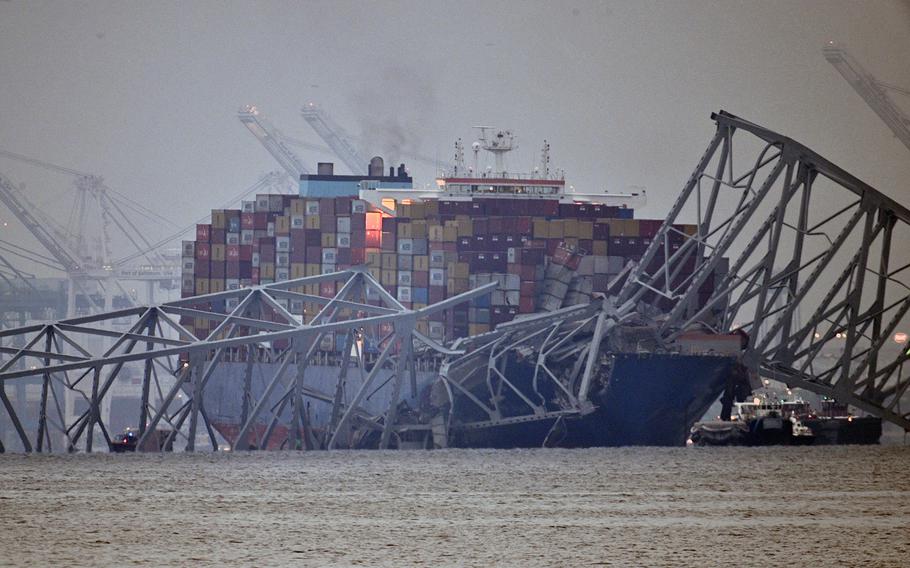
The container ship Dali Wednesday morning, March 27, 2024, at the site where it collided with the Francis Scott Key Bridge. (Jerry Jackson, The Baltimore Sun/TNS)
(Tribune News Service) — Immigrants built America. That’s an indisputable fact. But today there are many politicians and pundits who would like us to believe that the great contributions of immigrants stopped somewhere in the late 1800s with the completion of the Brooklyn Bridge.
This week provided a stark reminder of just how integral immigrants are to the nation’s infrastructure when two men died, and four more are missing and presumed dead, following the bridge collapse in Baltimore. A construction crew was working the overnight shift on the Francis Scott Key Bridge, filling potholes and fixing masonry issues, when a cargo ship hit one of the support pillars below. The structure crumpled, sending the men, their vehicles and parts of the bridge into the Patapsco River.
The bodies of Alejandro Hernandez Fuentes, 35, and Dorlian Ronial Castillo Cabrera, 26, were found Wednesday inside a red pickup truck submerged in 25 feet of water. Still missing were Miguel Luna, Maynor Suazo Sandoval and two other workers whose names have yet to be released. The search for the men has been called off .
Collectively they were beloved fathers, husbands, neighbors and avid soccer fans. They came here from El Salvador, Mexico, Honduras and Guatemala. And like so many immigrants before them, they made our lives easier by risking theirs.
According to the Bureau of Labor Statistics, foreign-born Hispanic or Latino workers made up 8.2% of the employed U.S. workforce in 2021 but accounted for 14% of work-related deaths that year. Fatal injuries to this group were most prevalent in the field of construction.
Depending on the decade or the century, numerous immigrant groups suffered similar fates while building and maintaining the nation’s roads, bridges and tracks. Throughout the 19th and early 20th centuries, it was migrants from Ireland, Germany, Italy and other parts of Europe who took on dangerous, back-breaking jobs. In the mid-1800s, it was Chinese workers who built the western leg of the transcontinental railroad across the Sierra Nevada. This list goes on.
There is now a great reverence for yesteryear’s immigrants who helped erect cities and forge highways. The much-deserved respect is a far cry from the discrimination they experienced in their respective eras thanks to an American tradition of stoking fear around new arrivals to the country. It’s a perennial blood sport that’s at the center of Republican politics today.
But there is still some grace left in our divided nation. News accounts and social media posts about the bridge workers have remembered them with sympathy and solemnity. Yet it’s hard to shake the idea that if this horrible accident hadn’t occurred and these men were simply seen laboring away on the side of the road, an unfortunate number of commuters might view them with fear and contempt while assuming they were in the country illegally.
It’s a horrible thought, but not far-fetched. Immigrants from South and Central American have been labeled “animals,” “MS-13” or “bad hombres” by politicians who seek office through hateful speech rather than substantive policy. Dicing words is no longer necessary in today’s xenophobia parade. Former President Trump bluntly stated that immigrants coming to the U.S. are “poisoning the blood of our country.”
“Nationality of immigrants continues to matter greatly,” says Ran Abramitzky, professor of economics at Stanford and co-author of “Streets of Gold: America’s Untold Story of Immigrant Success.” Political speeches mentioning Mexican immigration, Abramitzky adds, “are consistently more negative than speeches mentioning European groups. We also [see] a striking similarity between how Mexican immigrants are framed today and how Chinese immigrants were framed during the period of Chinese exclusion in the 19th century: more negative in tone; greater explicit emphasis on frames such as ‘crime,’ ‘labor’ and ‘legality’; and significantly greater use of implicit dehumanizing metaphors, in comparison to European groups.”
I don’t know what the immigration status was of the men who perished in Baltimore this week, and it doesn’t matter. They were doing what generations have done before them — working a tough if not dangerous job in the wee hours, when it was unlikely anyone would see or thank them for their work.
“Maynor and Miguel are just two stories, two specific examples of thousands and thousands of Baltimoreans that are making a contribution to this beautiful country,” said Gustavo Torres, the executive director of the Maryland-based Latino and immigrant organization CASA, at a news conference Wednesday. “In a time when there is so much hatred against the immigrant community, we look to the quiet leadership of Maynor and Miguel and appreciate how they uphold our society so that Americans can live comfortably.”
Perhaps we have to wait another 100 years for today’s immigrants to be recognized as an integral part of our country’s success, but wouldn’t it just be easier to drop this tired dance and do it now?
©2024 Los Angeles Times.
Visit latimes.com
Distributed by Tribune Content Agency, LLC.